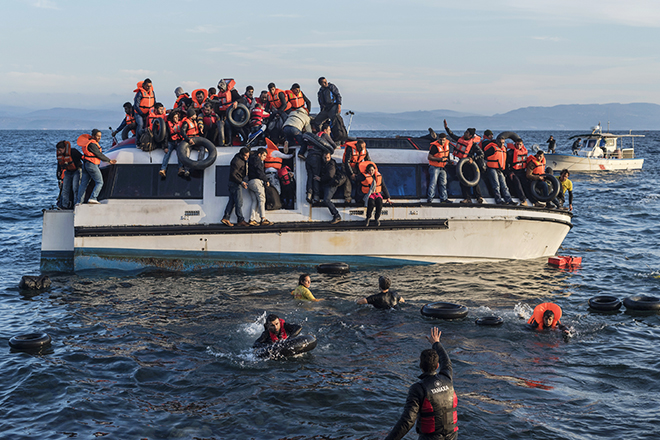
This post is the fourth entry in a series of commentaries on the EU Global Strategy on the Global Justice Blog.
Resilience and migration: an opportunity
The EU Global Strategy refers explicitly to the internal crisis of the European Union: ‘We live in times of existential crisis (…) our Union is under threat (…) our European project is being questioned (…) never has our unity been so challenged’. Unsolved existential issues threaten to tear the Union apart: what is the European Union and which values does it support? Where is the European project heading? Migration is a formidable test case for the European Union – especially because of its difficulties to provide clear answers to the above questions.
Migration is a formidable test case for the European Union.
‘Resilience’ is at the core of the EU’s long-term approach to migration, as evident in the EU Global strategy. The term resilience refers to ‘the ability of states and societies to reform, thus withstanding and recovering from internal and external crises’, by coping with potential fragilities. In the case of migration, promoting resilience is a reasonable and well-grounded way to face migration in the long term, as the Global strategy recognizes. It gives a stake to the many actors involved in the process and directly points at the root causes of the phenomenon.
The idea of sharing the practical and moral responsibilities of the governance of migration with third countries is not new. To the contrary, it has been the backbone of the EU external dimension to migration and asylum since its inception. Hence, what is new is the enhancement and formalization of this understanding in the EU’s Global Strategy.
Playing the great Pretender?
Yet recent moves by the Union cannot be sensibly regarded as justifiable attempts to ‘share the burden’ with resilient states. Two examples are the EU-Turkey Statement and the full support of the Italy-Libya agreement to curb flows of migrants. In the first case, Turkey has been involved to curb illegal crossings towards Greece as well as to take back all returned irregular migrants and asylum seekers whose applications are ‘unfounded or inadmissible’ (according to EU’s law). In the second, the European Union has endorsed and ensured financial backing to Italy’s effort to engage Libya in stemming ‘illegal migrants’ fluxes’ and to re-ignite cooperation with the country in other migration-related sectors.
These moves and the improvement of third states’ resilience have the same objective: to significantly reduce migrant inflows. While resilience is a long-term approach, these recent and ‘urgent’ moves meet an immediate need: to dilute tensions among member states and go ‘back to Schengen’. The Schengen area is regarded as ‘one of the greatest achievements of the EU’. At the same time, the chaotic and inefficient management of the massive arrivals of 2015 and 2016, coupled with increasing security alarms, have led some member states to reintroduce border controls within the EU free movement area.
Recent moves by the Union cannot be sensibly regarded as justifiable attempts to ‘share the burden’ with resilient states.
The EU’s rhetoric used to sell this short-term approach has involved hardly contestable arguments, like the need to avoid human suffering and thwart smugglers’ business. However, the EU gets less and less consistent, hence less and less convincing.
The Joint Communication on the Central Mediterranean route issued in January just a few days before the Italy-Libya Memorandum, acknowledges that Libya is highly unstable, that Sub-Saharan Africa suffers under violent conflicts and a severe economic situation. In particular, the Communication highlights that ‘a worrying trend is that the number of vulnerable migrants, especially women and minors, is increasing’. One would, therefore, expect the Union to emphasize the necessity for a humanitarian handling of the phenomenon. Yet we have seen few traces of this so far.
The real root causes of the challenge
Indeed, to the EU, preventing inflows appears as the only solution to the pressing short-term challenge: ensuring the integrity of the Schengen system. Commentators and practitioners have sharply criticized this attempt to outsource responsibility. Still, the EU hopes to solve the internal crisis and save the zone of free movement by keeping out potential causes of tension: chaotic and massive inflows of irregular migrants and asylum seekers. Yet what exactly is the EU saving, and at what cost? Does the EU have what it takes in terms of internal consistency, effectiveness, and moral standing to teach others about resilience and the way to reach it? Has the EU thoroughly reasoned on what being resilient actually means and implies?
About the author

Research fellow, University of Bologna

 The Global Justice Blog is an academic commentary from the research project Reconsidering European Contributions to Global Justice (GLOBUS).
The Global Justice Blog is an academic commentary from the research project Reconsidering European Contributions to Global Justice (GLOBUS). 
Log in to comment
Not UiO or Feide account?
Create a WebID account to comment